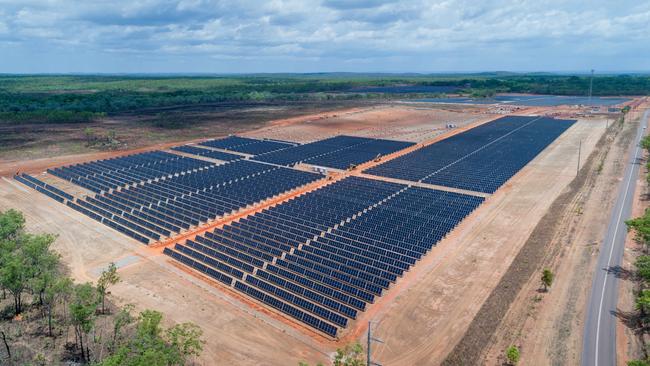Matt Cunningham analysis: NT government’s solar farm plan worthy of satire
The Territory government’s record on solar has done nothing to convince companies that the NT is a place worth investing in, writes Matt Cunningham.

Opinion
Don't miss out on the headlines from Opinion. Followed categories will be added to My News.
Territorians could be forgiven for thinking they were stuck in an episode of the ABC comedy series Utopia this week.
As regular readers of this column have long been aware, the NT government has had great difficulty connecting three large solar farms at Manton Dam, Batchelor and Katherine to its electricity grid.
The farms were finished more than three years ago but are still not providing any electricity to the grid because of concerns about system performance and reliability.
The farms were part of the Labor government’s grand promise when it came to power in 2016 to provide “cheaper, greener” renewable energy, setting a lofty goal of 50 per cent renewables by 2030.
Seven years on the green dream lies in tatters.
The solar farms are fast turning into white elephants while the independent Utilities Commission warns we are edging closer to the system collapsing.
In its latest Electricity Outlook Report the commission “forecasts risks to maintaining a secure Darwin-Katherine power system as early as 2026-27”.
One of the major reasons for this pending potential disaster is the large uptake in rooftop solar in the Top End.
Thanks to overly-generous government subsidies, Territory households and businesses have signed up to solar in huge numbers.
But this creates challenges for those in power generation who have to match supply with demand or risk everyone’s lights going out.
Not that this is of much concern to the average punter, who has been screaming blue murder ever since the government last year took the belated and necessary step to reduce the solar feed-in tariff.
If you’re still wondering why that happened, you’ll find the answer in the Utilities Commission’s report.
It notes the system security issues likely to arrive by 2026-27 are “due to falling minimum demand during the day as a result of increasing amounts of electricity from uncontrollable residential and commercial rooftop solar PV systems”.
So, given the glorious mess the government has managed to create, what did it do this week?

It announced a $200m expression of interest for three more, bigger, solar farms it says will contribute as much as 15 per cent towards its 50 per cent renewable energy target.
If you consider what has happened to Eni – the company which owns the solar farms at Manton Dam, Batchelor and Katherine – it’s difficult to see how any business in its right mind would be interested in building these farms.
Eni acquired the solar farms in 2019 under a deal that looked like it would deliver significant revenue within months.
In a media release from February 2019, Epuron, which had sold the Katherine solar farm to Eni, remarked that the project was expected to begin commercial operation later in 2019. “Electricity for the project will be supplied under a long-term power purchase agreement which Epuron negotiated with NT electricity retailer Jacana Energy.”
It must have seemed too good to be true. And it was.
Because after Eni had made this investment, the government — suddenly aware that pumping large amounts of intermittent solar energy into its already ageing electricity grid was a fast-track to disaster — changed the rules.
It introduced new generator performance standards requiring Eni to ensure that the power delivered from its solar farms could be better regulated.
This meant it suddenly had to wear the cost of battery storage, capacity forecasting and monitoring, something it has told the Utilities Commission will cost it more than $40 million. This whole episode will have done nothing to convince companies that the Northern Territory is a place worth investing in.

Still, with an election just 12 months away and the government keen to promote its green credentials, it’s now promising more, bigger solar projects to complement the failing ones it already has.
In 2020, the Utilities Commission said achieving 50 per cent renewables by 2030 would be “extremely challenging (if not unrealistic)”.
That challenge appears even less realistic now.
But, as the commission notes in its latest report, “there are ways to deal with all of these challenges”.
“It is likely the solution to this challenge will at least involve a combination of batteries, synchronous condensers, network changes and demand side management,” it says.
“Significant new investment will be needed to successfully achieve a transition to greater renewable energy.”
How much will this transition to “cheaper, greener” power cost? Don’t hold your breath waiting for an answer.





